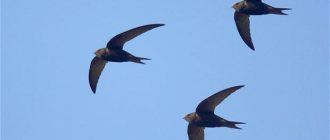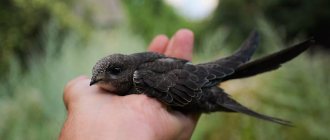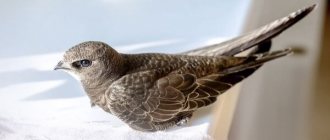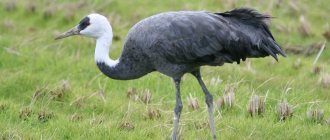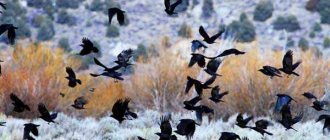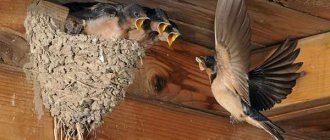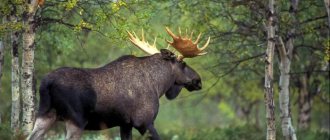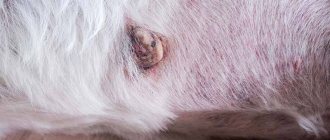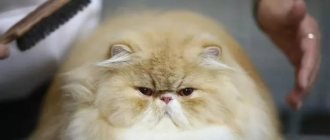Features and habitat of the swift
You can see this wonderful bird in any corner of our planet. You will not find it only in very cold climatic latitudes. They can settle both in forest areas and in treeless areas.
They give their preference to large cities and coastal cliffs, where it is convenient for them to arrange their nests. It seems that these birds never get tired. They spend almost all their time flying, and only spend a few hours at night sleeping. Thanks to the ideal aircraft, they can cover distances of hundreds of kilometers.
Description of the bird
The black swift, 16–17 cm long and weighing 40 g, differs from other species in its dark color without clearly defined areas, except for a vague white spot under the beak. While the plumage of older chicks is pale, that of adults is dark brown, tinged with blue and green.
Age is determined by color saturation. The darker it is, the older the bird. The unusual voice of swifts is manifested in whistling of different tones. Sometimes loud, shrill intonations are heard, a high thin whistle is emitted to attract a partner, and during the migration period there is a period of silence.
Due to the special structure of their visual organs, birds are farsighted and can focus their gaze with either one or two eyes. Life expectancy is 20 years, but some individuals live longer than 25.
Although the peregrine falcon (300 km/h) is considered the record holder for the speed at its peak, it is inferior to the flight speed of the black swift in the horizontal plane. A small bird can reach speeds of up to two hundred kilometers per hour, while a member of the falcon family is only up to one hundred.
If a swift finds itself on the ground, strong legs and long wing feathers help it take off. Having jumped, the bird manages to push off with its outstretched wings.
The character and lifestyle of swifts
Among these bird species there are both sedentary and migratory ones. They prefer to live in flocks. Entire colonies can be seen in cities or in the mountains, numbering several thousand pairs of swifts. Their activity does not decrease from morning to evening. Their energy reserves do not run out. They have a very strong metabolism and, accordingly, an excellent appetite. Birds have well-developed vision and hearing.
Swift birds reach flight speeds of up to 160 km/h
An interesting fact is that swifts can sleep in flight, not for a couple of minutes, but for several hours, only occasionally flapping their wings. It should be noted that this is not a completely peace-loving bird, although they live in large families.
They are big bullies and brawlers, and often get into quarrels not only with their fellow birds, but also with other species of birds. It’s hard to call them smart or cunning. Their character is dominated by excessive temper, due to which sometimes they can even forget about their safety.
Swifts are very responsive to temperature changes. If after warm weather it suddenly gets colder, their thermoregulation cannot cope with this difficult task and the swift falls into hibernation. Birds do not build neat nests compared to other birds.
The photo shows a nest of swifts
It is enough for them to carry the building material into one pile and hold it together with their quickly hardening saliva. Swifts have few enemies due to their fast flight speed. Only falcons can threaten them, catching swifts on the fly.
Small swift chicks may not appear from the nest for a long time; this can last up to two months. All this time, caring parents take upon themselves the issue of feeding their children, bringing food to their babies in their beaks.
Feeding rules
It happens that the swift feeds itself, grabbing food from its fingers, but if the chick has already grown up and refuses to eat from the hands, you need to try to find the way the parents fed the chick - move the insects along the beak from different sides, provoking it to grab the food.
If the chick refuses to eat on its own, then it is necessary to force feed. To do this, you need to wrap the swift in a napkin, so as not to damage or stain the plumage, and carefully, opening the beak from the side, put the insect in the mouth. The swifts' beak is very fragile; it cannot be opened by the tip, because it can break; it must be opened only from the side; do not use sharp or hard objects! There are many videos on YouTube with examples of feeding swifts - you can watch and learn.
Swift nutrition
The main food of swifts are insects that fly in the air. From this it follows that the nutrition and life in general of swifts is completely dependent on weather conditions. If insects disappear due to the onset of cold weather, swifts also have to change their place of residence.
From hunger, the temperature of these birds drops significantly, this can result in the so-called “trance sleep”. Thanks to this pattern in the body, birds can survive hunger from one to ten days. This helps the little chicks wait for their parents, who have flown far away in search of food.
The black swift is one of the bird species that differs slightly in its size and plumage color. At the beginning of May, he flies from warm regions to places to which he is accustomed and with loud cries notifies us that spring has finally fully come into its own.
Listen to the voice of the black swift
Black swift bird
Most often, black swifts winter in Africa and India. Initially, they liked living on the rocks most of all, but gradually they fell in love with city life and it is now not uncommon to meet them in the city.
Is the swift a migratory bird or not? People often ask this question. The answer is unequivocal - yes. They are heat-loving birds. They do not leave only those regions where the temperature allows them to exist freely and without problems all year round.
Keeping a chick at home
A bird that spends its entire life in the sky is completely unsuitable for life in captivity. Moreover, the appearance of the swift is not at all as colorful as that of parrots or canaries, and the voice is by no means a nightingale.
Therefore, when it comes to keeping a tower swift at home, we usually mean an attempt to save a found creature (wounded or not yet able to fly), with the goal of subsequently returning it to the wild.
Domesticated birds also include Amadina and canary.
House for the swift
“Legless” birds require a very special approach to housing. Swifts cannot be kept in a cage, since this type of bird is not adapted to walking on the ground, or even to sitting on a perch. In a cage, such a bird will very quickly receive irreparable injuries - broken feathers and wings.
For this reason, for a live find, you need to equip a large box with sides that are at least twice the total length of the bird’s body including the tail. It is fundamentally important that, having spread its wings completely, the “tenant” does not touch the walls of his home with them.
To avoid injury, it is advisable to cover all the walls of the box with soft material, not forgetting to make several holes in them so that the pet does not suffocate (the top of the house must be covered, otherwise the bird will try to get out, which means it may get hurt).
Any moisture-absorbing material from what is sold in pet stores is suitable as bedding, but you can get by with ordinary napkins.
Important! The less lighting in the box, the calmer its occupant will tolerate temporary captivity.
The box should be placed in a dark place so that when the lid opens, the bird does not get scared and injure itself. It is possible, although not necessary, to build a shelter made of soft material inside the box into which your pet can crawl for safety.
The ambient temperature should fluctuate between 25-35°C, although swifts tolerate cold and heat well, but a draft can greatly harm them. The best option is if the heat source is located under the bottom of the box, and not on the side or top.
What to feed and what not to feed a swift if you found it on the street and brought it home?
If you find a bird, bring it home and decide to help it, then a serious question is what you can feed and what you cannot feed. Let's look at these two lists in more detail.
It is strictly forbidden to feed swifts:
— Maggot for fishing;
- Cat soft and hard food, and nothing at all, including dog food;
- do not give sausages, sausages and similar products;
— industrial bird feed is prohibited;
- you can’t give carrots;
— chicken meat from the store is also not allowed;
- a mash for insectivorous birds made from insects is not allowed;
- any type of eggs, boiled or raw, no matter what kind of birds, is prohibited;
- sunflower seeds from the store, neither raw nor roasted;
- cottage cheese, sour cream and other dairy products from the store are not allowed;
- if you have sticky tape with flies hanging in your room, it is also forbidden to give them to swifts;
- In general, forget about feeding food that you and your pets eat.
Need to feed:
Since the main diet of swifts is insects, they need to be fed only with them, moreover, they must be caught directly from nature, and not raised somewhere in an aquarium for business.
— pupae (eggs) of forest red ants (Formica rufa). Also store in the freezer, before feeding, rinse on a sieve and blot with a napkin, a video of how swifts eat them is below;
— crickets, which need to be stored in the freezer, should be thawed before feeding and given after blotting them with a napkin to remove excess water. Do not feed rotten ones; you can identify them by their dark color and rotten smell. In female crickets, it is necessary to remove the eggs from the abdomen, since they are not digested by swifts;
— molted mealworm larvae, only white, soft, without chitinous cover;
— Turkmen cockroaches, feeding instructions below;
If you have prepared suitable food for your swift, but he does not open his mouth, below is a video on how to do this:
Swifts also need vitamins, so we recommend giving thiamine (B1) 1-2 drops in a volume of 0.04 ml every 5-7 days. Otherwise, the bird may experience convulsions due to vitamin deficiency.
Origin of the species
The black swift, like other species of the swift family, was classified by Carl Linnaeus as a swallow, citing the similarity of foraging for food in flight. In his work “Systems of Nature,” the scientist designated the birds as Hirunso apus, which translated from Greek means “without legs.”
Englishman Colin Harrison and South African ornithologist Richard Brooke analyzed the evolutionary chain based on fossil remains. Behavior, distribution area, and anatomical differences were taken as the basis.
After studying changes in the length and strength of the ulna bones, ornithologists came to different conclusions. Harrison claims that the ancestor of swifts and hummingbirds is the genus of extinct birds Eocypselus; Brook considers the ancestor of Cypseloidinae. Species boundaries remain controversial.
Reproduction and lifespan
Every spring, migratory swifts return to their former places of existence. They have a surprisingly excellent memory. They are quickly busy building their nests because the time to lay eggs is approaching. Mostly swifts lay 2 eggs.
In the photo there is a swift chick
The black swift can have 4 of them. The female incubates them for two to three weeks, all this time the male is searching for food for the two of them. Newborn chicks live dependent on their parents for about 40 days, after which they grow stronger, become independent and leave the nest forever. The lifespan of these birds is 10-20 years.
Pictures of a swift bird evoke only tenderness. Especially those that depict chicks and their caring parents nearby. Simultaneous helplessness and such guardianship, which is not typical even for some people, force us to treat swifts with respect.
the swift has been chosen as the bird of the year for several years . Many poems and riddles were written for the children about the swift bird and its speed. Many people know about its existence from early childhood.
Lifestyle
Young swifts reach sexual maturity in the second year of life. And they become “family men” in the third year. Active reproduction lasts only two years – the third and fourth. The search for a partner begins upon returning to the permanent nesting sites. Still in the air, they find a mate, mate, and only after that acquire a nest.
For nesting in the wild, swiftlets are suitable for rock crevices and holes on steep banks. In urban environments, they nest in cracks under roofs and balconies. According to ornithologists, swifts can also expel smaller birds from already occupied places, and destroy their eggs or offspring.
There are known cases when males entered into fights for a partner and/or nest. This is evidenced by the appearance of birds with bloody wings at nests as a result of fights.
Swifts build their nest from straws, fluff, hair, that is, from everything that they can catch in the air. In nature, nests are located no lower than three meters above the ground.
Female swifts in different regions of their habitat lay eggs at different times. But basically this process occurs from late May to early June. The clutch of a swift consists of two to three eggs. The incubation period (how long the partners will incubate them) ranges from sixteen to twenty-two days. Both swifts hatch eggs. Due to inclement weather, the incubation period may increase.
As a rule, chicks do not appear simultaneously, but with a gap of one to two days. The first chick always has the advantage. The third one most often dies when unfavorable conditions occur.
The chicks are born completely naked and blind. Within two weeks, they open their eyes and begin to become covered with the first down.
A chick eats up to a thousand insects per day. They accumulate reserves of nutrients in case of unfavorable conditions. For example, in cloudy weather, when the parents fly more than a hundred kilometers from the nesting site. Then the chicks are plunged into suspended animation without harm to their health.
They can remain in this state for up to five days. After this, the supply of nutrients drops to a critical minimum, below which the chick dies.
Feeding of the chicks occurs in the order of “the hungriest – the most well-fed.” The swift, having received its portion, moves back and the next one comes to take its place. After feeding, the chicks immediately empty the nest, and the parents clean the nest of any remaining feces.
The chicks spend about forty days in the nest. Young individuals begin to obtain food for themselves along with their parents shortly before migration.
Where does it live?
Black swifts are found everywhere. Favorite nesting places are European and Asian territories inhabited by humans, tall forests with a mild climate.
The range extends to Eurasia, Africa, North and South America, excluding Greenland, Argentina, and Chile. Birds were not found in deserts, Iceland, on some oceanic islands, north of Russian Transbaikalia.
Swifts often choose landscapes created by man, but also willingly settle in pine forests and aspen forests with a rich food supply. They choose places near natural reservoirs and extensive clearings that serve as places to hunt for insects.
If earlier swiftlets nested exclusively in mountainous areas, now they prefer the proximity of people.
Wintering
For the winter, swifts travel to Africa in mixed flocks. They fly close to each other, reaching speeds of up to 250 km/h. They get to the place quickly, in 4–5 days.
The migration patterns of black swifts were studied by a group of scientists from Sweden led by Suzanne Akesson. Researchers tracked the movements of hundreds of individuals from different European populations for several years and came to the following conclusions:
- the northern populations went for the winter and returned home a month later than the southern ones;
- Lapland swifts migrated to the west of Africa and to the central regions, Italian and Spanish populations, in addition to the central part of the continent, inhabited the southeast of the continent;
- unlike other warm-blooded species, representatives of the northern colonies weigh less than those living in the south;
- small body size makes it easier to endure the hot African climate;
- competition for nesting sites in the southern regions caused an increase in body weight.
The timing of migration depends not only on the length of daylight hours, but also on the weather.
What does it eat?
The bird's diet consists of:
- small spiders;
- ants;
- gadflies, flies;
- beetles;
- wasps, bees;
- butterflies;
- aphids, cicadas, whiteflies.
Insect species vary depending on trawling height, habitat, and seasonality. Studies of the stomach of the black swift have shown that the diet is based on proboscis pests of agricultural crops, with significantly less dipterans. After the chicks are raised, these insects in the diet are replaced by less nutritious beetles with a hard chitinous cover.
Birds hunt at different heights, but more often up to 50 m above the treetops. When con, short-term mixed groups with swallows are created in certain areas.
The need for water is satisfied by flying over large and small bodies of water.
